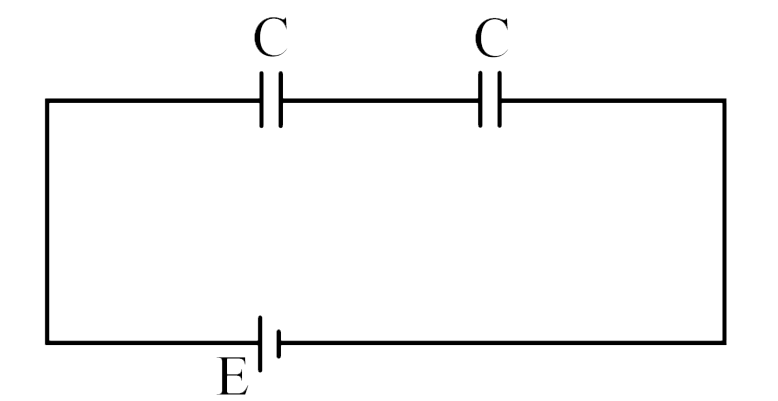Two parallel plate air capacitance C, were connected in series to a battery with emfξ. Then one of the capacitors was filled up with uniform dielectric with permittivity ε. How many times did the electric field strength in that capacitor decrease ? What amount of charge flows throgh the battery ?
The correct Answer is:EiEt=12(1+k),Δq=12Cεk−1k+1
Step by step video, text & image solution for Two parallel plate air capacitance C, were connected in series to a battery with emf xi. Then one of the capacitors was filled up with uniform dielectric with permittivity epsilon. How many times did the electric field strength in that capacitor decrease ? What amount of charge flows throgh the battery ? by Physics experts to help you in doubts & scoring excellent marks in Class 12 exams.
Topper's Solved these Questions
- BOOK - RESONANCECHAPTER - CAPACITANCEEXERCISE - Exercise - 274videos
CAPACITANCE
- BOOK - RESONANCECHAPTER - CAPACITANCEEXERCISE - Exercise - 326videos
CAPACITANCE
- BOOK - RESONANCECHAPTER - CAPACITANCEEXERCISE - Miscellaneous Solved Example3videos
CAPACITANCE
- BOOK - RESONANCECHAPTER - ATOMIC PHYSICSEXERCISE - Advanved level problems17videos
ATOMIC PHYSICS
- BOOK - RESONANCECHAPTER - COMMUNICATION SYSTEMSEXERCISE - Exercise 313videos
COMMUNICATION SYSTEMS
Similar Questions
Two parallel plate capacitors of capacitance C each are connected in series with a battery of emf ε. Then, one of the capacitors is filled with a dielectric of dielectric constane K.
i. Find the change in electric field in the two capacitors, if any
ii. What amount of charge flows through the battery?
iii Find the change in the energy stored in the circuit, if any.View SolutionTwo parallel plate air capacitors, each of capacitance C=50 were connected is series ot emf ε=100V. Then one of the capacitors was filled with a uniforme dielectirc of relative permittivity ε=5 Compare the before and after the insertion of the dielectric? What amout of charge flows from the battery?
View Solution
Knowledge Check
- Question 1 - Select One
Two parallel plate air capacitance of same capacity C are connected in series to a battery of emf E. Then one of the capacitors is completely filled with dielectric material of constant K. The change in the effective capacity of the series combination is
AC2[K−1K+1]B2C[K−1K+1]CC2[K+1K−1]DC2[K−1K+1]2 - Question 2 - Select One
Two identical parallel plate air capacitors are connected in series to a battery of emf V. If one of the capacitor is completely filled with dielectric material of constant K, then potential difference of the other capacitor will become
AKV(K+1)BKVK+1CK−1KVDVK(K−1) - Question 3 - Select One
Two parallel plate air filled capacitors each of capacitance C, are joined in series to a battery of emf V. The space between the plates of one of the capacitors is then completely filled up with a uniform dielectric having dielectric constant K. The quantity of charge which flows through the battery is -
ACV2(K−1K+1)BCV2(K+1K−1)CCV(K−1K+1)DCV(K+1K−1)
Two parallel plate capacitors, each of capacitance 40 muF, are connected is series. The space between the plates of one capacitor is filled with a dielectric material of dielectric constant K =4. Find the equivalent capacitacne of the system.
View SolutionTwo identical parallel plate capacitors of capacitance C each are connected in series with a battery of emf, E as shown. If one of the capacitors is now filled with a dielectric of dielectric constant k, the amount of charge which will flow through the battery is (neglect internal resistance of the battery)
 View Solution
View SolutionTwo capacitors of capacitance C are connected in series. If one of them is filled with dielectric substance K, what is the effective capacitance?
View SolutionA parallel plate capacitor of capacitance 10μF is connected across a battery of emf 5 mV. Now, the space between the plates of the capacitors is filled with a deielectric material of dielectric constant K=5. Then, the charge that will flow through the battery till equilibrium is reached is
View SolutionTwo capacitors of capacitance C are connected in series. If one of them is filled with dielectric substance K, what is the effective capacitance?
View Solution

